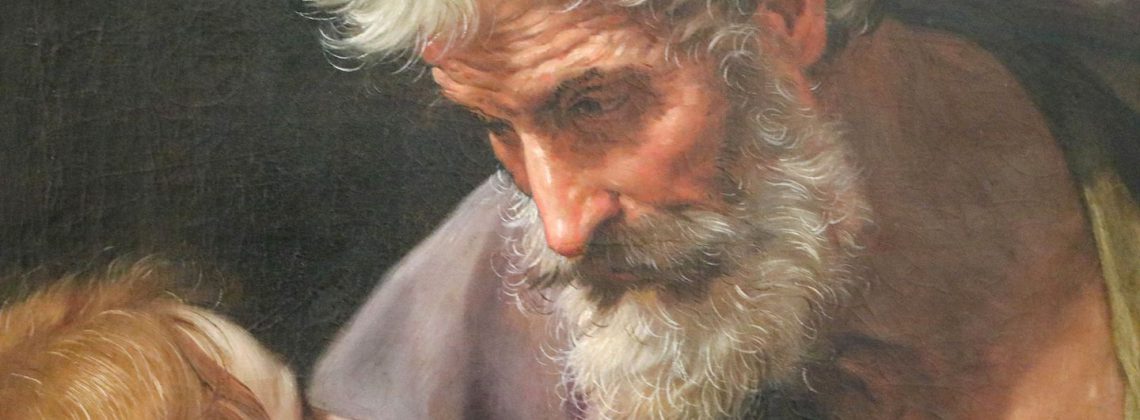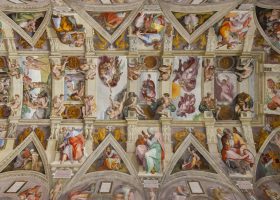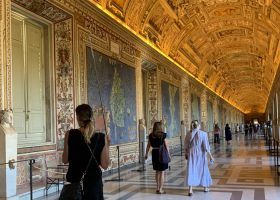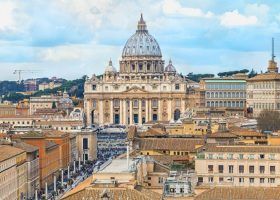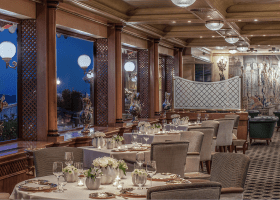Planning to visit the Vatican but unsure what famous artwork you should see? Don’t worry! We’ve run tens of thousands of Vatican tours, which makes us Vatican experts. Here is what we believe are the most famous paintings you absolutely must see when visiting the Vatican
Pro Tip: Planning your visit to the Vatican? Bookmark this article in your browser so you can easily find it when you’re in the Museums. It contains tons of information that will elevate your Vatican visit. Also, see our dedicated guide to Vatican City for more planning resources, our top Vatican tours for a memorable trip, and how to visit the Vatican.
Paintings You Should See At The Vatican
Art is about emotion. It’s about an artist unleashing their innermost thoughts and feelings onto canvas for all to witness. It’s such a powerful act, that many have been criticized, scrutinized, and even killed just for making art.
If you look at a painting and don’t feel anything, you likely haven’t heard its story. This is why we recommend guided tours. An expert art history guide skilled in the art of storytelling will make your visit that much more memorable and you’ll come away with a much deeper appreciation for the art. That’s what we do!
As you prepare for your Vatican Museums visit, you might also want to check out our ultra-comprehensive list of what to see at the Vatican written by a licensed Vatican guide! Here are the most famous paintings to see at the Vatican Museums.
Not ready to book a tour? See if a Vatican tour is worth it.
17. Astronomical Observations
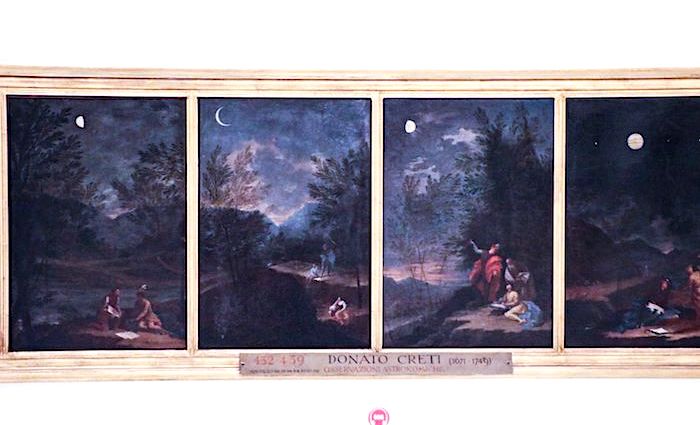
Donato Creti | 1711 | Oil on Canvas | Pinacoteca
The Bolognese count Luigi Marsili commissioned this series of paintings to create a collection and gift them to pope Clement XI. The idea was to create a strong case for the church to understand the importance of an astronomical observatory. Pope Clement blessed it and an observatory opened soon after in Bologna, so his plan worked.
The collection comprises eight canvases, which show the astronomical bodies known at the time: the Sun, Moon, Earth, Mars, Venus, Jupiter, Saturn, and a comet. The only one missing is Uranus, which would only be discovered in 1781.
In the painting, you’ll notice various telescopes and optical instruments that astronomers used to observe the celestial bodies at the time. In the background, you’ll also see many figures observing these gigantic bodies in 18th-century clothing.
Personally, I feel that looking at this painting allows you to travel back in time to the early 18th century and see what it would have been like to be an astronomer in those days. Imagine the excitement of looking into the night sky and seeing all of these heavenly bodies 250 years before TV! The power of their instruments is also on display here since we know they could already see the rings around Saturn!
16. Adam and Eve In The Garden Of Eden
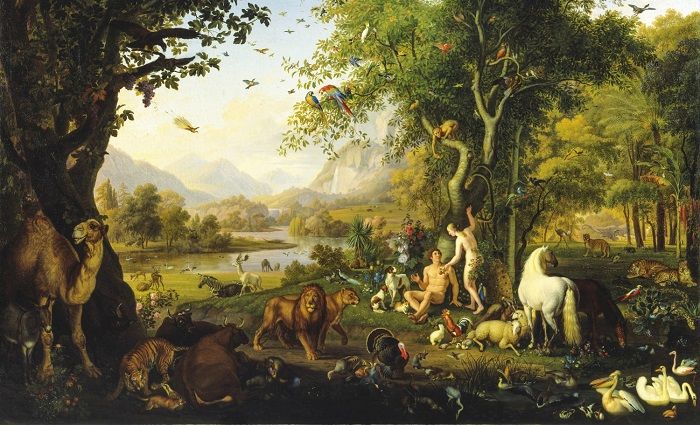
Wenzel Peter | 1828 | Oil on Canvas | Pinacoteca Room XVI
This painting may strike you as odd at first, but you’ll see that it is one of the most devout paintings in the Vatican collection. What may look like a scene from the Jungle Book is actually the Garden of Eden.
Wenzel Peter was an animalist painter, which means that he specialized in painting animals of all sorts. Due to his dedication to one particular type of painting, he was able to portray these animals in an extremely realistic way. Either sitting or standing, the figures look so true to form it could almost be a photograph.
The masterpiece portrays the Garden of Eden with Adam and Eve. They are both pleasantly portrayed here as two young people living in paradise. There’s nothing vulgar or too “realistic” about them and both of them are covered naturally so as not to show any indecency.
There are over 200 animals from all over the world in this painting and precisely portrayed. Since this is the Garden of Eden, you’ll notice that the animals, regardless of type, are all living in harmony together with humans. This is how it would have been in the beginning, according to Genesis.
Best Tours of the Vatican
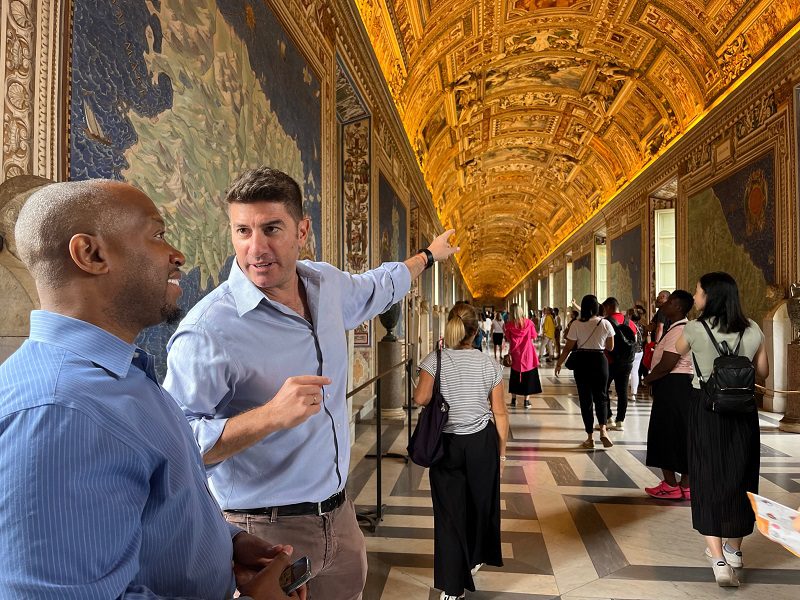
Privileged Entrance Vatican Tour with Sistine Chapel & St. Peter’s Basilica
3 Hours | €€€
Skip the line and gain direct access to the Raphael Rooms, Creation of Man & Scala Regia passageway.
Book Now!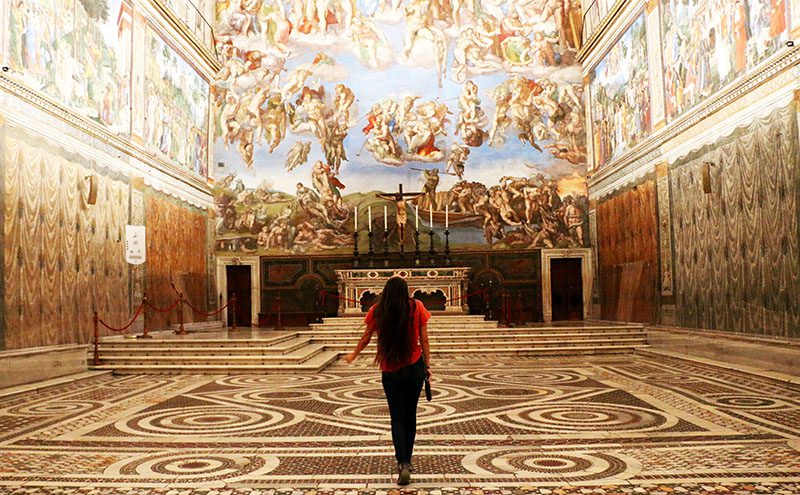
Exclusive Sistine Chapel After Hours Small Group Tour
2 Hours | €€€€
Step inside the Vatican Museums after they close to the public for a once-in-a-lifetime experience.
Book Now!
Rome in a Day Tour with Colosseum and Vatican Museums
7 Hours | €€€
Enter the Sistine Chapel, Roman Forum, and see St. Peter’s Dome, Pantheon, Trevi Fountain, and more.
Book Now!15. The Crowning of the Virgin
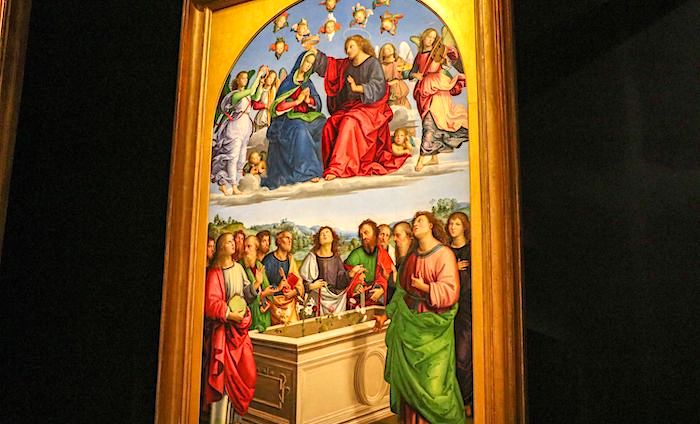
Raphael | 1502 – 1503 | Tempera on Wood | Pinacoteca Room VIII
When I was 19 years old, I was roaming the bars of Bologna. At the same age, Raphael painted The Crowning of the Virgin. This is one of my personal favorites because of the simple and elegant beauty of the individual figures depicted.
The Crowning of the Virgin was part of the altarpiece for the Oddi family chapel in Perugia. The painting is broken down into two scenes. The bottom half shows the grave where the Virgin Mary was laid to rest with the apostles around her. St. Thomas holds the girdle, which the virgin herself gave him as a gift. There are flowers where she would have been in the tomb as she had already ascended to heaven. The apostles are all looking in amazement as they see her image above with Jesus.
The upper portion of the painting depicts the Virgin Mary and Jesus, who is crowning her as the blessed mother. There are angels surrounding them and some are even playing musical instruments. The play on color is similar to the Transfiguration, where the darker colors are below. As your eyes naturally move upwards, the color scheme becomes lighter. The faces show the ideal beauty of man, which is expressed even more so in the angelic face of the Virgin Mary.
14. St. Jerome
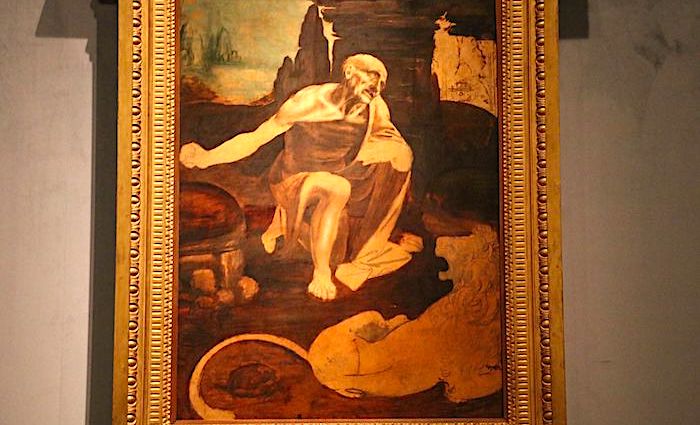
Leonardo Da Vinci | 1482 | Oil on Wood | Pinacoteca Room IX
Da Vinci wasn’t just a master painter but also an engineer, inventor, and even a builder of siege weapons. This is one of the most enigmatic paintings by the master, Da Vinci, and the story behind it is even more intriguing. Da Vinci was known for not finishing many of his commissions. While this art piece is only a sketch, it reveals the genius of the man.
It shows St. Jerome who, for his love of God, lived as an ascetic for many years in the Syrian desert. He is always depicted in an emaciated manner, and this sketch is no different. Old and bald in the picture, he has the look of a man who has endured serious pain in his life. He’s sitting down with the lion at his feet (his companion after having pulled a thorn from the lion’s foot). Also, he holds a rock in his hand, which he would traditionally use to beat himself on the chest as penance.
The Story Behind St. Jerome
The story is quite fascinating as it appears that it was divided into two pieces. The lower part, found in a second-hand shop, was used as the cover for a box. The upper part with St. Jerome’s head on it was found at his shoe maker’s and used as a cover for his stool. Upon his death, it was auctioned and exchanged hands a few times. Pope Pius IX finally bought it in 1856 where it has been ever since.
The sketch became the property of Angelica Kauffmann, a Swiss painter, and was lost at the beginning of the nineteenth century. It was discovered by Cardinal Joseph Fesch, uncle of Emperor Napoleon, cut into two parts and was being used as household scrap wood. It is amazing to think about how many priceless works of art may still be scattered around the world.
Enrico Bruschini, Art Historian
Not ready to book a tour? Find out if Rome tours are worth it.
13. Transfiguration
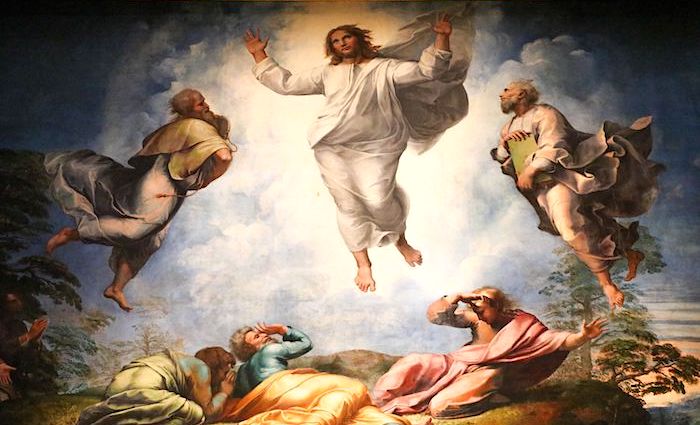
Raphael | 1518 – 1520 | Tempera on Wood | Pinacoteca Room VIII
This artwork was made specifically to be an altarpiece, so it would be up above our heads. Our eyes are naturally drawn to brighter colors, and Raphael played on this by gradually making the colors brighter the further up you look. In doing so, Raphael guides you on how to look at the scene. Start at the bottom and then work your way up to the top of the painting, culminating in Christ himself.
The painting depicts two stories from the Gospel according to Matthew. They are the Transfiguration and the meeting of the apostles with the obsessed youth who would be cured when Jesus returns from Mount Tabor. The mastery of the painting is shown in numerous ways, so let’s start with the color. Raphael was famous for his use of vivid colors. Especially now, after the painting has been cleaned, we can see the colors the way Raphael and his contemporaries would have seen them.
This was Raphael’s last painting. Georgio Vasari, Raphael’s contemporary and biographer, called this painting “the most famous, most beautiful, and most divine.” It was supposedly laid over his tomb during his funeral. Unfortunately, Raphael died at the young age of 37, supposedly from syphilis. He was buried, and remains to this day, in the Pantheon in Rome.
Seeing his body dead, and his work so alive, it felt as if our heart would break in two.
Giorgio Vasari, Contemporary and Biographer of Raphael
12. The Annunciation
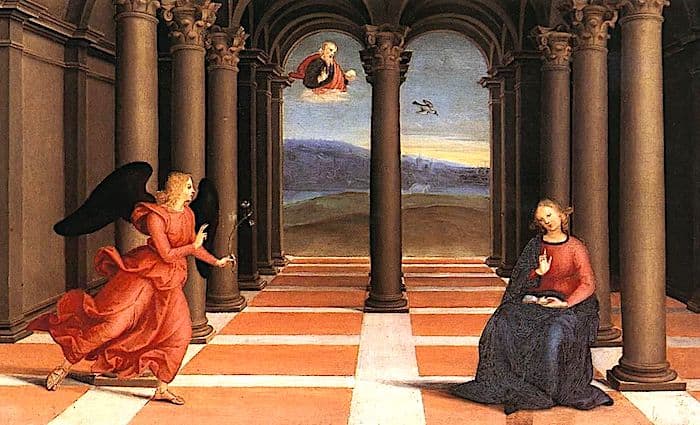
Raphael | 1502 – 1504 | Tempera on Wood | Pinacoteca Room VIII
Commissioned for the Oddi family for their family chapel in Perugia, the Annunciation was painted between the years 1502-1504. This is one of Raphael’s earliest works.
The angel Gabriel approaches the Virgin Mary to let her know of the imminent coming of Jesus Christ (Annunciation). Mary sits by herself reading a book and seems to be expecting this moment. With ideal beauty reflected in her face, we see this even in the way she holds up her one hand welcoming the Angel.
In the background, you can see two arches that open up to a clear sky. One of Raphael’s trademarks was to add deep perspective in his paintings, which he does here with a light blue colored sky to show the most distant point.
You’ll also notice the 3D effect he creates with the columns and the dove in the distance. This painting resembles a very similar work by his teacher Perugino. Raphael would have studied under the Early-Renaissance master and, eventually, he achieved such mastery that many said they couldn’t tell the difference between master and student.
Best Tours of the Vatican
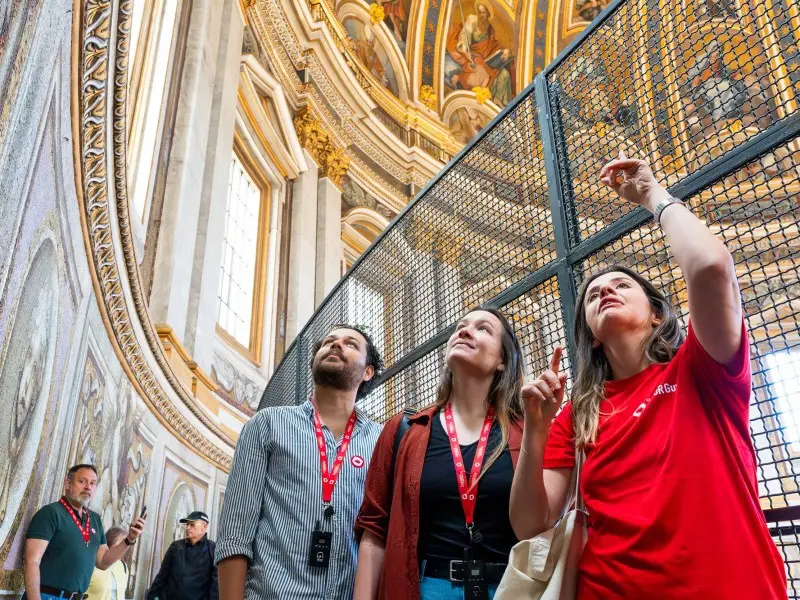
St. Peter’s Dome Climb and Sistine Chapel Combo Tour
5 Hours | €€€
See Rome from above then go deeper into the Vatican’s highlights and Michelangelo’s masterpieces.
Book Now!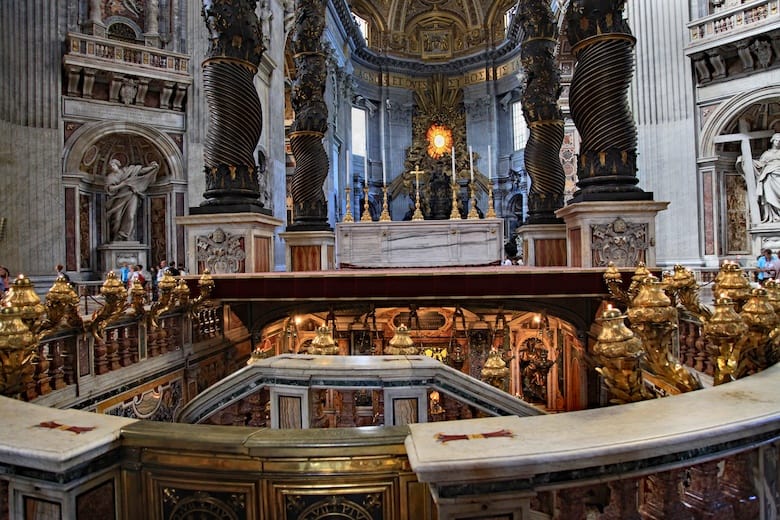
St. Peter’s Basilica Express Tour with Papal Crypts
1 Hour | €
Marvel at Michelangelo’s Pietà, Bernini’s Masterpieces, and Sacred Tombs in St. Peter’s.
Book Now!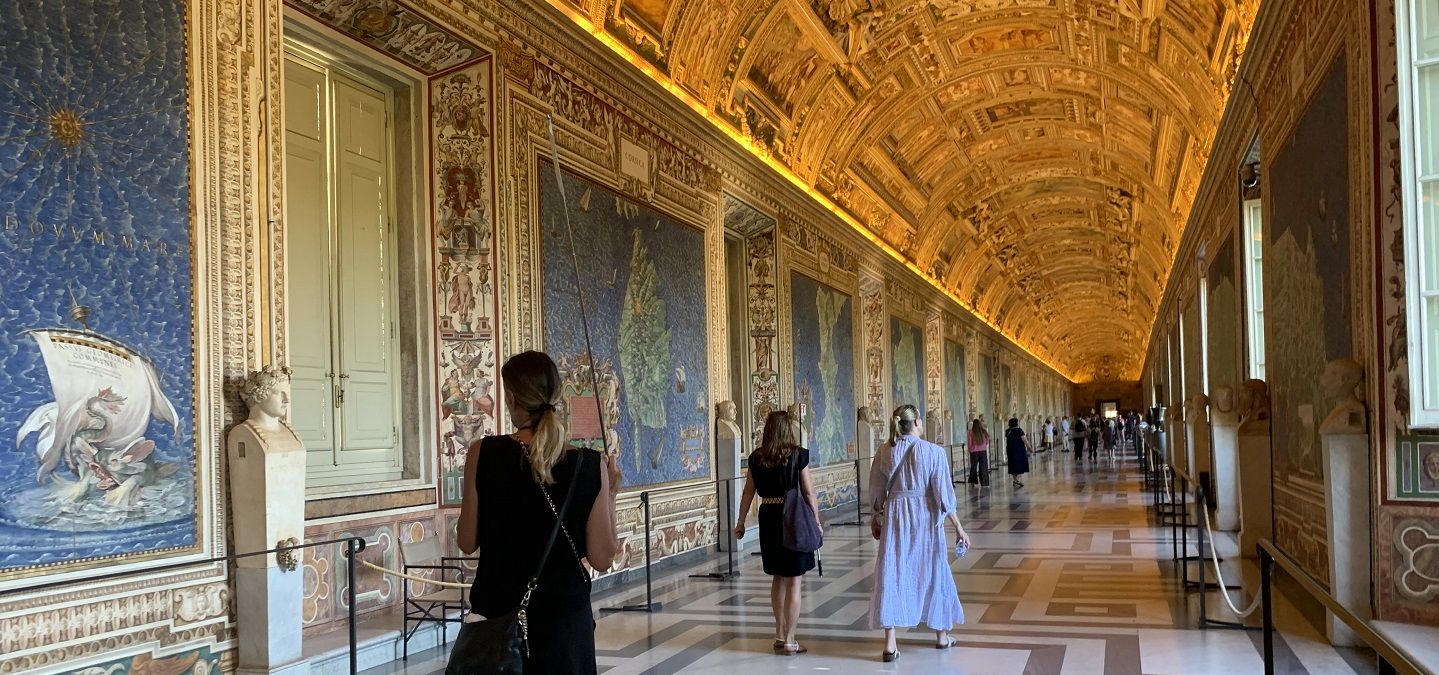
Private Skip the Line Vatican, Sistine Chapel, and St Peter’s Basilica Tour
3 Hours | €€€€
Enjoy a tailored VIP Vatican Museums and St. Peter’s Basilica experience with a dedicated private guide.
Book Now!11. Vision of the Cross
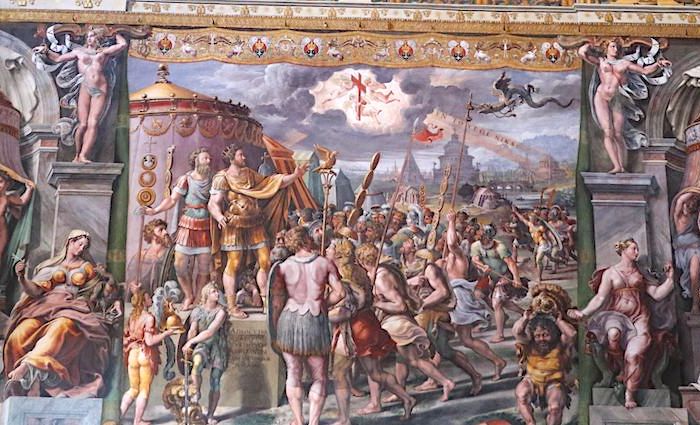
Giulio Romano (Raphael’s Drawing) | After 1520 | Fresco | Raphael Rooms: Hall of Constantine
Raphael died quite young—at the age of 37. So, he didn’t actually paint any of the frescoes in the Hall of Constantine even though they are attributed to him. This is because he made the actual drawings and his students painted according to his plans. For example, this particular painting was done by his best student, Giulio Romano.
The night before the decisive battle against his enemy Maxentius, Constantine saw a white cross burn across the night sky. This premonition led him to believe that if he replaced the emblem of eagles with the cross, he would be victorious.
Remember that Christianity in the Roman Empire up to this point was pretty much illegal, although widely tolerated. Needless to say, having the Emperor replace the Eagle with a Christian symbol was a pretty big deal.
In the lower right corner of the fresco, we see a dwarf who carries an enormous gold helmet. This is not an invention of the painter, but rather a graceful homage to a dwarf who actually lived at the papal palace as the court jester of Pope Leo X and whose name, fortunately, has been conserved: Gradasso (the Boaster) Berrettai.
Enrico Bruschini, Art Historian
10. The Victory Of Christianity Over Paganism (Ceiling)
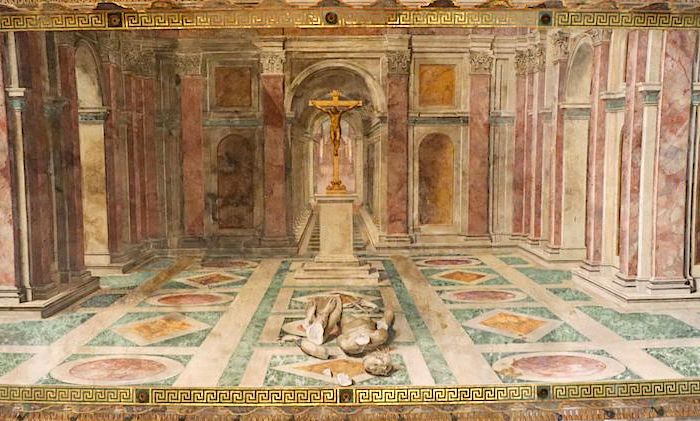
Tommaso Laureti | 1585 | Fresco | Raphael Rooms: Hall of Constantine
This jewel of a painting is missed by most people—don’t forget to look up at the ceiling! If ever there was one image to encapsulate the expression “A picture paints a thousand words,” this is the one.
What better way to show one’s triumph over another? You replace the exact thing you triumphed over! Originally, there was a statue of the pagan god Mercury (Greek Hermes) on the pedestal. Replaced by a Christian cross, the previous statue (or symbol) has been crushed to pieces below. There is no truth behind this, but I imagine that this scene actually happened at one point.
I have stared at this painting many times and what never ceases to amaze me is the depth Laureti was able to achieve in the painting. The 3D effect on a 2D form is mesmerizing.
Top Hotels in Rome
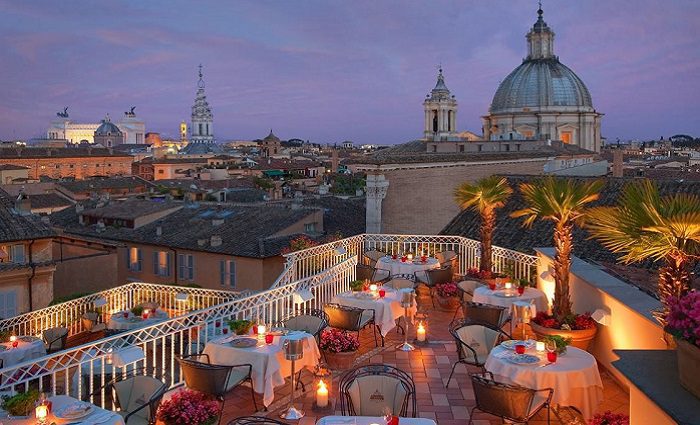
Bio Hotel Raphael ⭐⭐⭐⭐⭐
Piazza Navona • Terrace
Luxury hotel with a rooftop restaurant plus spacious and calming suites near Piazza Navona.
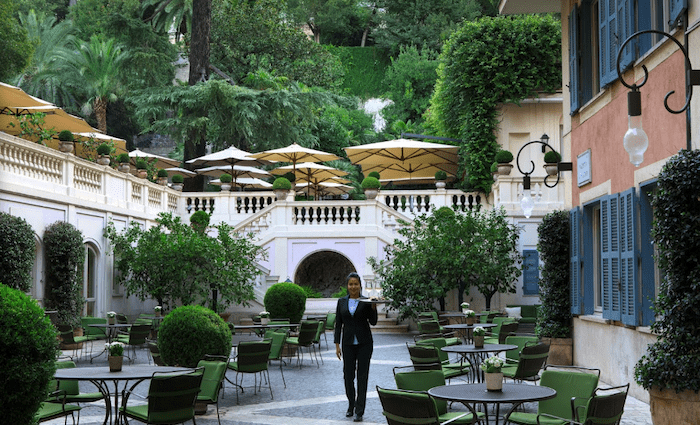
Hotel de Russie ⭐⭐⭐⭐⭐
Timeless Luxury • Spanish Steps
Popular hotel for VIPs like Bruce Springsteen with a classic Italian style and a dreamy courtyard.
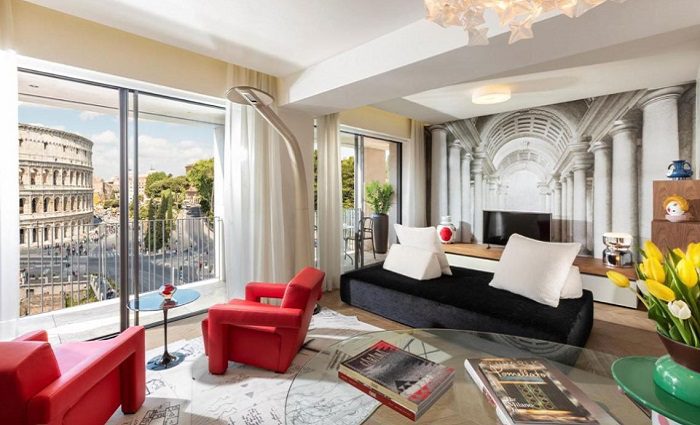
Palazzo Manfredi ⭐⭐⭐⭐⭐
Luxury • Near Colosseum • Terrace
Wake up to views of the Colosseum and enjoy meals on a stunning terrace in this top hotel in Monti.
9. Liberation Of St. Peter
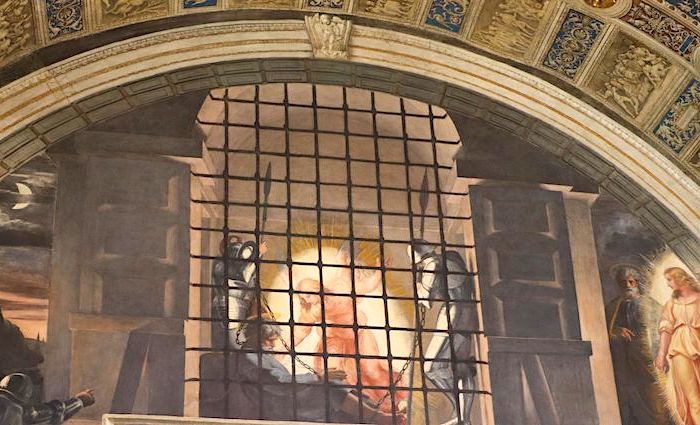
Raphael | 1512 | Fresco | Raphael Rooms: Room of Heliodorus
This entire fresco is a brilliant display of light effects. As you look closely at the painting, you’ll notice first the extreme splendor of the light of the angel herself whose glow reflects in the armor of the stunned prisoners in the room. Compare that with the light of the rising Sun to the left and also the natural light coming in from the window below.
Raphael was able to show, 500 years ago, how a room could be lit up in a painting. Besides the light, the robust colors used makes this painting shine. I remember walking into this room for the first time after it had been cleaned and the vibrance of colors was shocking!
Remember also that the medium used to paint this was fresco, which is unforgiving. You have to be fast and make no mistakes—a detail that makes this painting even more precious.
The story is about the first pope, St. Peter, who is a prisoner in Rome. In the evening, an angel comes and breaks his chains to set him free. Julius II commissioned this painting since, before becoming pope, he was the Titular Cardinal of St. Peter in Chains in Rome. In that church, you can still see the chains St. Peter wore that were broken by the angel.
8. Fire in the Borgo
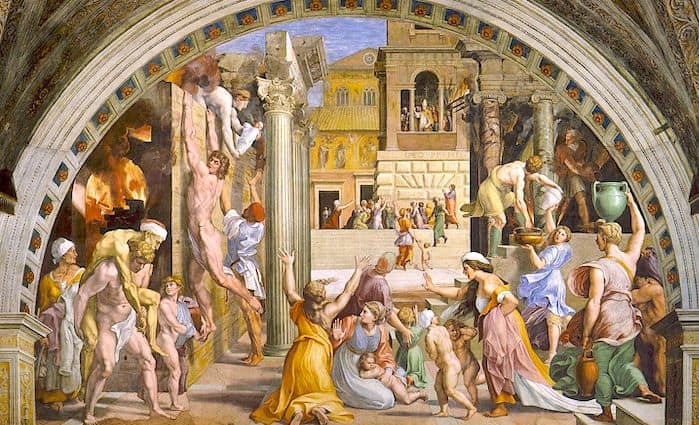
Raphael | 1514 – 1517 | Fresco | Raphael Rooms: Room of the Fire in the Borgo
By now, I think you may have noticed that I am a fan of Raphael’s work. Having said that, I can still call him out when he does weird stuff. What is the first thing that you notice in the painting? Aside from the story, look at those muscles! The women, children, and elderly all have excessive muscle tone. The men have muscles popping out of places where muscles don’t even exist! More on this later.
This painting shows a story from the “Liber Pontificalis” that told of a huge fire breaking out in the Borgo (the area around St. Peter’s church) in 847. The story goes that everyone was in a panic and Pope Leo IV (847 to 855) solemnly walked out on the balcony of his palace, blessed the fire, and it was extinguished immediately.
When they were painting this room, the Sistine Chapel had already been unveiled and Michelangelo’s muscular figures had become famous. Raphael’s students adopted this style, which you can see in this painting. However, they should have studied anatomy a bit more.
Not ready to book a tour? Check out our best Vatican tours to take and why.
7. Crucifixion Of St. Peter
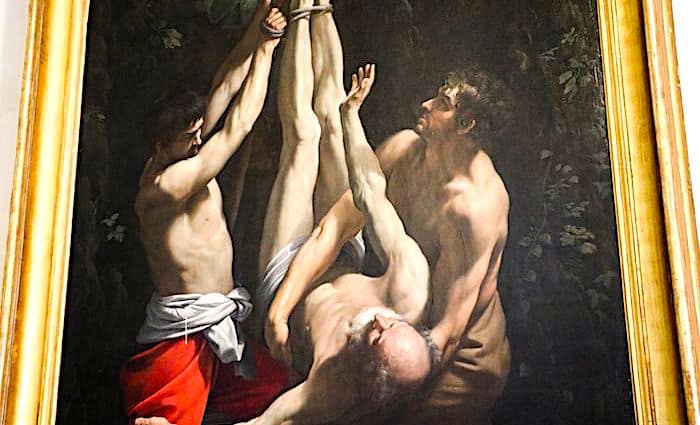
Guido Reni | 1604 – 1605 | Oil on Wood | Pinacoteca Room XII
It’s impossible not to speak about Caravaggio when you see this painting, whose influence on Guido Reni in this painting is undeniable. The first thing you notice is the real-life muscle tone of St. Peter.
You can see that there’s nothing idealized here and this could have been a real representation of what his body looked like. Next, you’ll notice there’s no perspective, so nothing is happening in the background—there’s only blackness. This allows you to focus 100% of your attention on the scene taking place.
St. Peter is being crucified for his Christian faith during the reign of Nero in A.D. 68. St. Peter didn’t feel worthy of the same death as Jesus and requested to be crucified upside down, depicted here.
This painting marks Guido Reni’s first success in Rome. It was commissioned for the Cardinal Pietro Aldobrandini for the S. Paolo alle Tre Fontane church. Afterwards, it was sent to Paris like so much other artwork and eventually brought back to Rome in 1819 by Pius VII. It has remained in the Pinacoteca ever since.
Almost all of the painters of the day, and those who followed, were strongly influenced by Caravaggio’s use of new colors as well as by his new and powerful naturalism. No one has ever been able to imitate him, however.
Enrico Bruschini, Art Historian
6. Martyrdom Of St. Erasmus
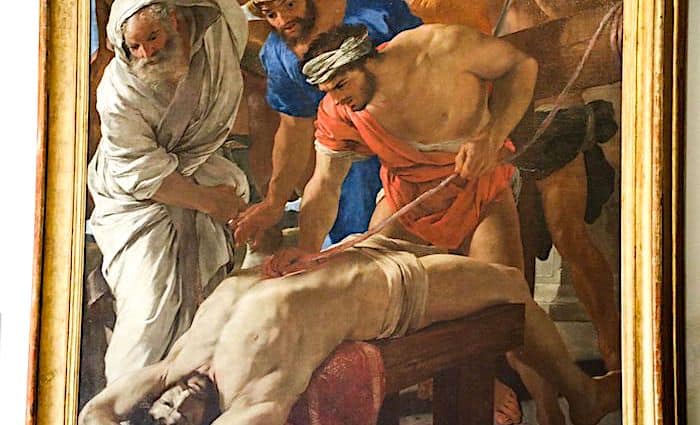
Nicolas Poussin | 1629 | Oil on Canvas | Pinacoteca Room XII
Nicolas Poussin (pronounced POOH-SAHN) was born in Normandy, France. However, he spent most of his life in Italy and was definitely Italian at heart. Like many, (myself included) once in Italy, the magical spell of this country trapped him. This dramatic painting is Nicolas Poussin’s first in Rome and not for the faint-hearted.
The painting depicts the martyrdom of St. Erasmus during the persecutions of Emperor Diocletian in A.D. 303. The future saint is stretched out with his hands behind his back, while the executioner pulls his intestines from his body and rolls them around a sailor’s capstan. Above him is a pagan priest pointing at a statue of Hercules that Erasmus refused to pray to. There are also angels coming down to him, offering him the palm and crown—both symbols of martyrdom.
Besides the graphic nature of the painting, Poussin used extremely vivid colors in this painting, especially white, blue, and red. At this point, we are at the height of baroque and also the realist movement started by Caravaggio (see below). Most people don’t know that this painting was actually commissioned to the painter Pietro da Cortona. However, it was then handed over to Poussin who even used the preparatory sketches made by da Cortona for the painting.
Intended for the altar in the right transept of St. Peter’s Basilica, the subject of the painting was chosen for the relics of the saint preserved there. Also taken to Paris and finally returned to Rome in 1820 by Pius VII, this painting found a home in the Pinacoteca where it remains to this day.
5. Deposition
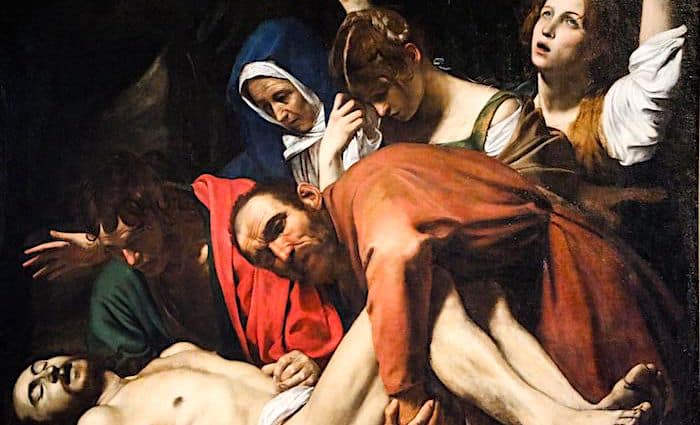
Caravaggio | 1604 | Oil on Canvas | Pinacoteca Room XII
Caravaggio may have been interesting company, but probably not someone you’d want to introduce to your family. His life was anything but usual. For example, he walked around Rome with a sword, was supposedly part of a local gang, and even killed a man in a duel.
As a result of the killing, he was forced to flee Rome and traveled south painting along the way from Naples to Sicily, Malta, and back. As the story goes, he was waiting for a pardon from Pope Urban VIII when one of his enemies finally caught up with him and killed him in Porto Ercole.
Until then, there were set templates dictating how to paint saints and holy people—to be painted with ideal beauty and purity. Caravaggio smashed these concepts by depicting them as ordinary people with defects. This revolutionary idea forever changed the art world.
In one of Caravaggio’s greatest masterpieces, we see Jesus not being laid in the tomb, but on the anointing stone by Nicodemus and John. Close to him are the Virgin Mary, Mary Magdalene, and Mary of Cleophas who raises her arms and eyes towards heaven in prayer.
It’s an extremely pious moment with expressions of sadness on everyone’s faces. There is no perspective—only blackness—and you can see the muscles bulging from Nicodemus’ legs. There is nothing ideal expressed here except the extreme agony that everyone present is experiencing.
Why follow the manner of other artists when you can follow nature itself?
Michelangelo Merisi—Caravaggio
Best Tours of the Vatican

Privileged Entrance Vatican Tour with Sistine Chapel & St. Peter’s Basilica
3 Hours | €€€
Skip the line and gain direct access to the Raphael Rooms, Creation of Man & Scala Regia passageway.
Book Now!
Exclusive Sistine Chapel After Hours Small Group Tour
2 Hours | €€€€
Step inside the Vatican Museums after they close to the public for a once-in-a-lifetime experience.
Book Now!
Rome in a Day Tour with Colosseum and Vatican Museums
7 Hours | €€€
Enter the Sistine Chapel, Roman Forum, and see St. Peter’s Dome, Pantheon, Trevi Fountain, and more.
Book Now!4. School of Athens
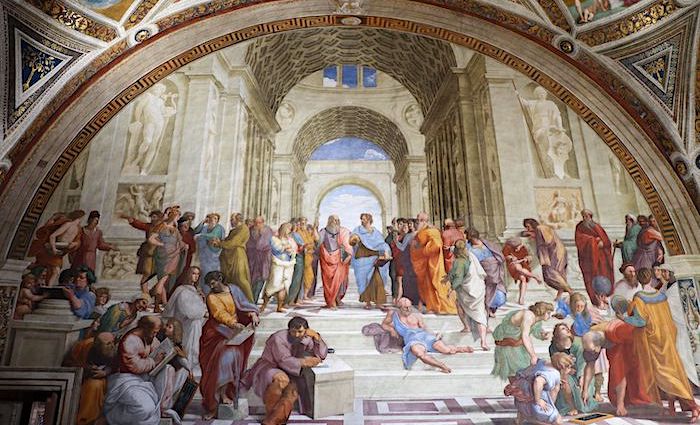
Raphael | 1508 – 1511 | Fresco | Raphael Rooms: Room of the Segnatura
The School of Athens is arguably one of the most famous paintings by Raphael due to its widespread use in textbooks. With this painting, he established himself as one of the most famous High Renaissance painters in the world. The painting, for our purposes, is actually famous for two reasons.
Firstly, it is harmonious, symmetrical, and celebrates ideal beauty in all its forms, which was important in Renaissance paintings. Secondly, this painting is basically a yearbook of the most famous artists of the early 15th century. Raphael used the faces of his friends as models for some of the famous people:
- Leonardo Da Vinci is Plato pointing a finger in the air.
- Bramante is Euclid, bending over a chalkboard.
- Raphael puts himself in the painting on the far right side staring directly at us.
According to legend, while Raphael was painting this room, Michelangelo was painting the Sistine Chapel. One day, he got a peek of what Michelangelo was doing and was so impressed that he came back upstairs and broke a piece of plaster off the wall and painted the face of Michelangelo as a tribute to how good he was.
Raphael saw the frescoes of Michelangelo and changed style.
Giorgio Vasari, Raphael’s contemporary and biographer
3. St. Matthew
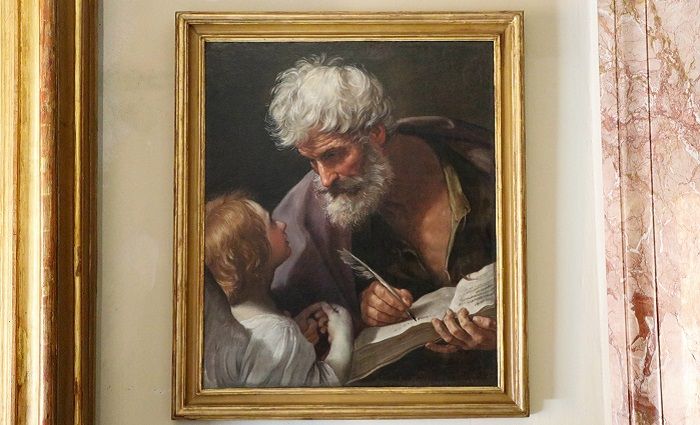
Guido Reni | 1635 – 1640 | Oil on Canvas | Pinacoteca Room XII
Sometimes, you see a piece of artwork and it just mesmerizes you. The intensity of the gaze and connection between these two figures is the most profound I have ever found in a painting. Stand in front of this painting in real life at the Vatican Museums and see if it has the same effect on you.
This piece shows the Apostle Matthew as he takes a break from his writing to look at an angel. Gone are the days of ideal beauty and deep perspective from the High Renaissance as we look at this masterpiece.
As a result, the apostle has been depicted as an old man we would recognize today, with wrinkles on his forehead, disheveled hair, and straining veins in the neck. The angel has rosy cheeks and an almost anemic look that you could find in many boys today.
The magic is the inaction itself. Neither of them is speaking. The angel looks up at St. Matthew in a loving manner who returns the look of affection with his own loving gaze. Out of context, you would simply see a painting of a grandfather and grandson expressing their love for each other. They don’t need to speak; they understand each other perfectly.
Top Hotels in Rome

Bio Hotel Raphael ⭐⭐⭐⭐⭐
Piazza Navona • Terrace
Luxury hotel with a rooftop restaurant plus spacious and calming suites near Piazza Navona.

Hotel de Russie ⭐⭐⭐⭐⭐
Timeless Luxury • Spanish Steps
Popular hotel for VIPs like Bruce Springsteen with a classic Italian style and a dreamy courtyard.

Palazzo Manfredi ⭐⭐⭐⭐⭐
Luxury • Near Colosseum • Terrace
Wake up to views of the Colosseum and enjoy meals on a stunning terrace in this top hotel in Monti.
2. The Last Judgement
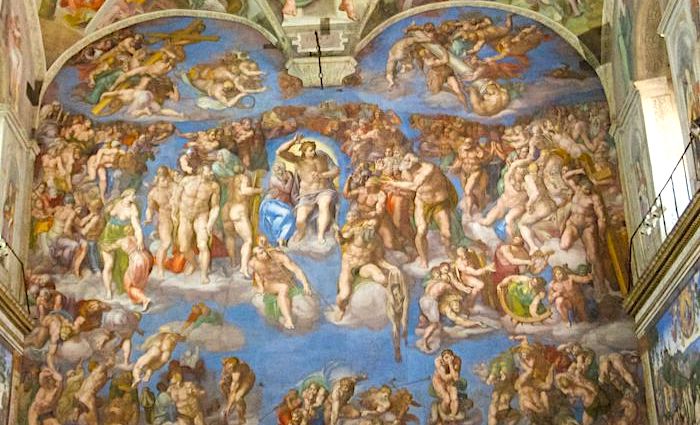
Michelangelo | 1536 – 1541 | Fresco | Sistine Chapel
Picture any 61-year-old man you know and imagine them painting a 42-foot high and 39-foot long wall for the next five years. On top of that, they would need to be able to produce a painting that would be described as one of the best ever created in the history of man. I don’t personally know any 61-year olds who could do that today. This is why Michelangelo is arguably the greatest of all time.
In the Last Judgement, all of the sinners will be sent down to Hell’s eternal fire and all of those who believe and repent will be allowed to enter the Kingdom of Heaven. The world is ending at this point and Michelangelo portrays this perfectly, adding many elements of classic literature as well.
The Top
In the upper lunettes, angels are carrying instruments used during the Passion of Christ (the cross, the whip, the column he was whipped on, and the crown of thorns). Below, an extremely muscular Jesus with no beard in a powerful position is presiding over the entire scene with a radiant halo bursting behind him.
Recognizable figures include John the Baptist, the Virgin Mary, St. Peter holding the keys, and various other saints holding the instrument they were martyred with in their hands.
The Middle
Below, there is a group of angels blowing trumpets and holding two books that decide their fate—ascend to heaven or descend to hell. Those redeemed ascend from their graves while the condemned descend into the underworld.
The Bottom
Here, Michelangelo alludes to Greek mythology with the demon (Charon) on a boat who brings all the souls of the damned to the underworld. On the far right side, you will see the Devil himself and all the damned and lost souls behind him in Hell.
Interesting Facts
When the painting was unveiled, many were shocked by the amount of nudity in the painting. Cardinal Biagio da Cesena said that this was better suited for a tavern than the holy chapel of the pope. It is said that Michelangelo then replaced the face of the devil with that of the cardinal, wrapping a snake around his body and biting him in the groin area.
Below Jesus, you’ll find St. Bartholomew who was skinned alive. He holds a knife in his right hand and his own skin in his left. Many contemporaries suggested that Michelangelo did a self-portrait in the skin!
If people knew how hard I worked to get my mastery, it wouldn’t seem so wonderful at all.
Michelangelo
1. The Sistine Chapel Ceiling
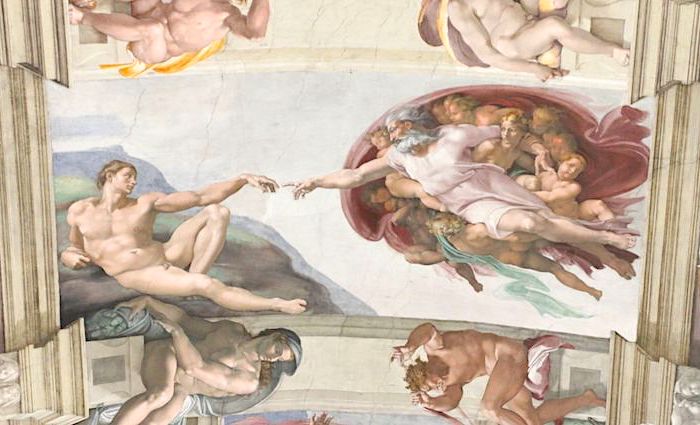
Michelangelo | 1508 – 1512 | Fresco | Sistine Chapel
Julius’ decision to repaint the ceiling probably had to do with structural damage caused during the excavations for the Borgia Tower and the new St. Peter’s Basilica. At the time, Michelangelo was working on the pope’s tomb and seemed to be quite content with this.
As the story goes, Bramante, who was upset with Michelangelo for a previous slight, suggested to the pope that Michelangelo should paint the ceiling even though he was a sculptor and not a painter. Julius agreed and Michelangelo, pretty much against his will, signed the contract to paint the ceiling.
The original design was to be the twelve apostles. However, after Michelangelo objected, Julius put the design in the master’s hands and the rest is history. Michelangelo had many problems/hardships going into this job. For example:
- He was a sculptor, not a painter.
- Having never really painted in this medium, his first attempt at fresco painting basically resulted in the most famous painting in the world.
- He had to build his own scaffolding before he could even reach the ceiling, which was 60 feet high.
- Since he was a perfectionist, he basically painted the entire thing by himself.
- There was no centralized heating, so he complained of stifling heat in the summer and numbing cold in the winter.
- He developed an eye disease during the painting, which only went away once he finished the ceiling years later.
The Ceiling
The ceiling is broken down into Central Panels, Sibyls and Prophets, Christ’s forefathers, and four corner stories. The heart of the ceiling is the nine central panels with arguably the most recognizable painting in the world—the Creation of Man panel. These central panels are:
- Separation of Light from Darkness
- Creation of the sun, moon, and planets
- Separation of Land from Sea
- Creation of Man
- Creation of Eve from the Body of Adam
- Banishment from the Garden of Eden
- The Sacrifice of Noah
- The Flood
- The Drunkenness of Noah
I cannot tell you how much I wished you were here, for until you have seen the Sistine Chapel, you can have no adequate conception of what man is capable of accomplishing.
Johann Wolfgang von Goethe
Not ready to book a tour? Check out our best Vatican tours to take and why.
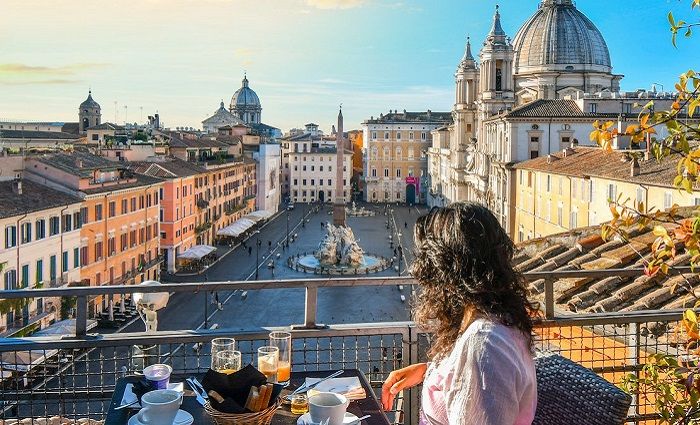
Where To Stay in Rome
Rome has a rich cultural history and many iconic landmarks to explore. Plan where to stay in the magnificent Eternal City in the best neighborhoods.

